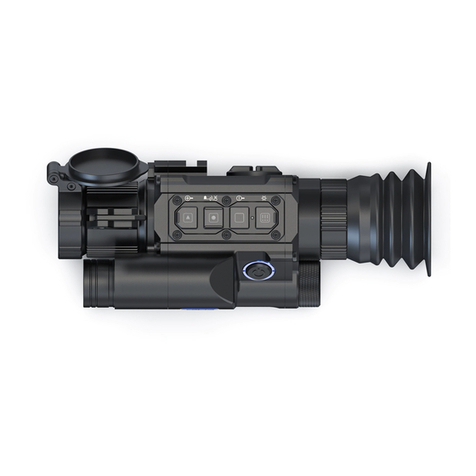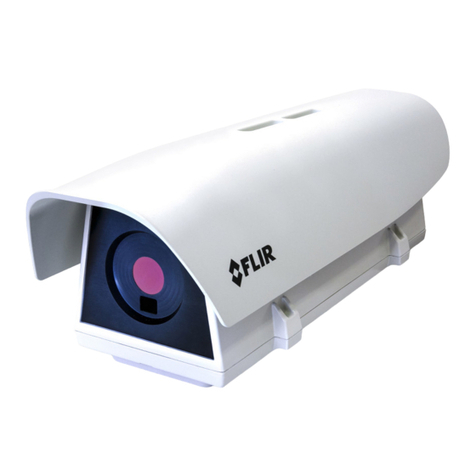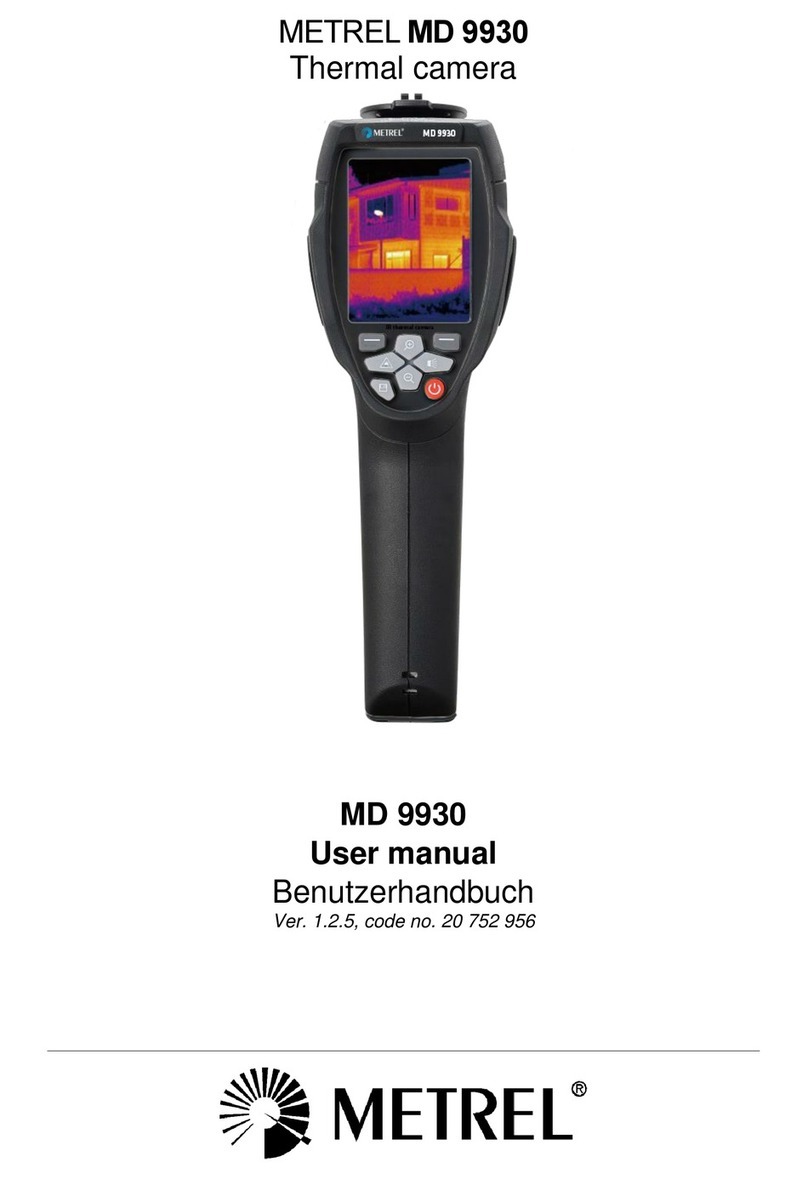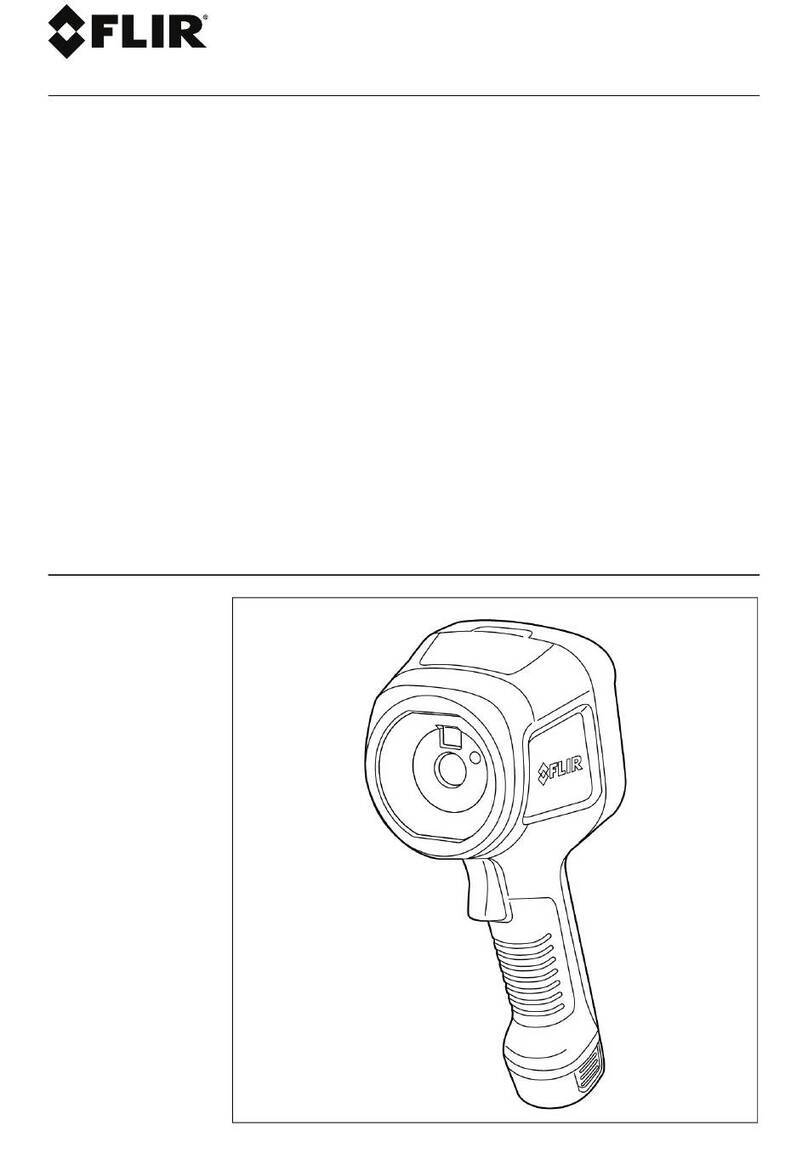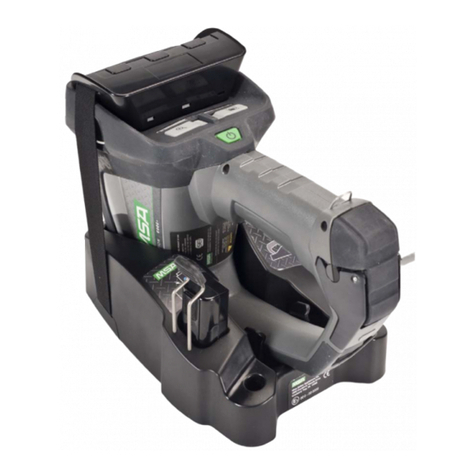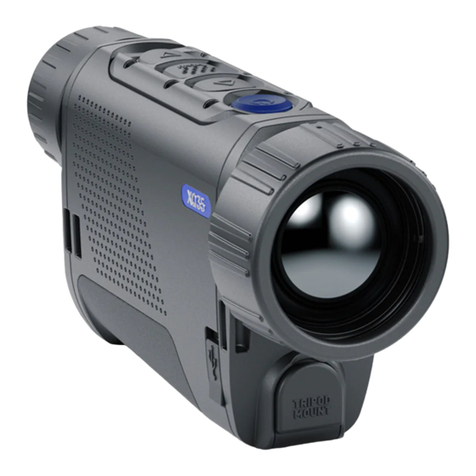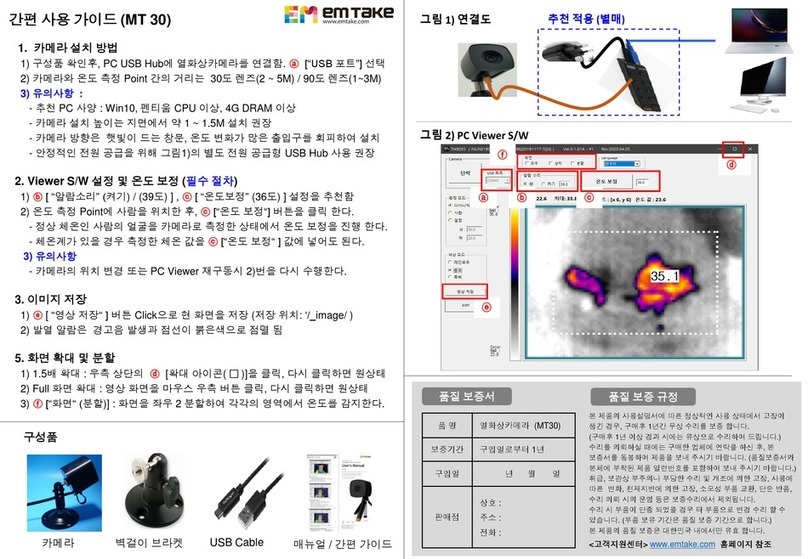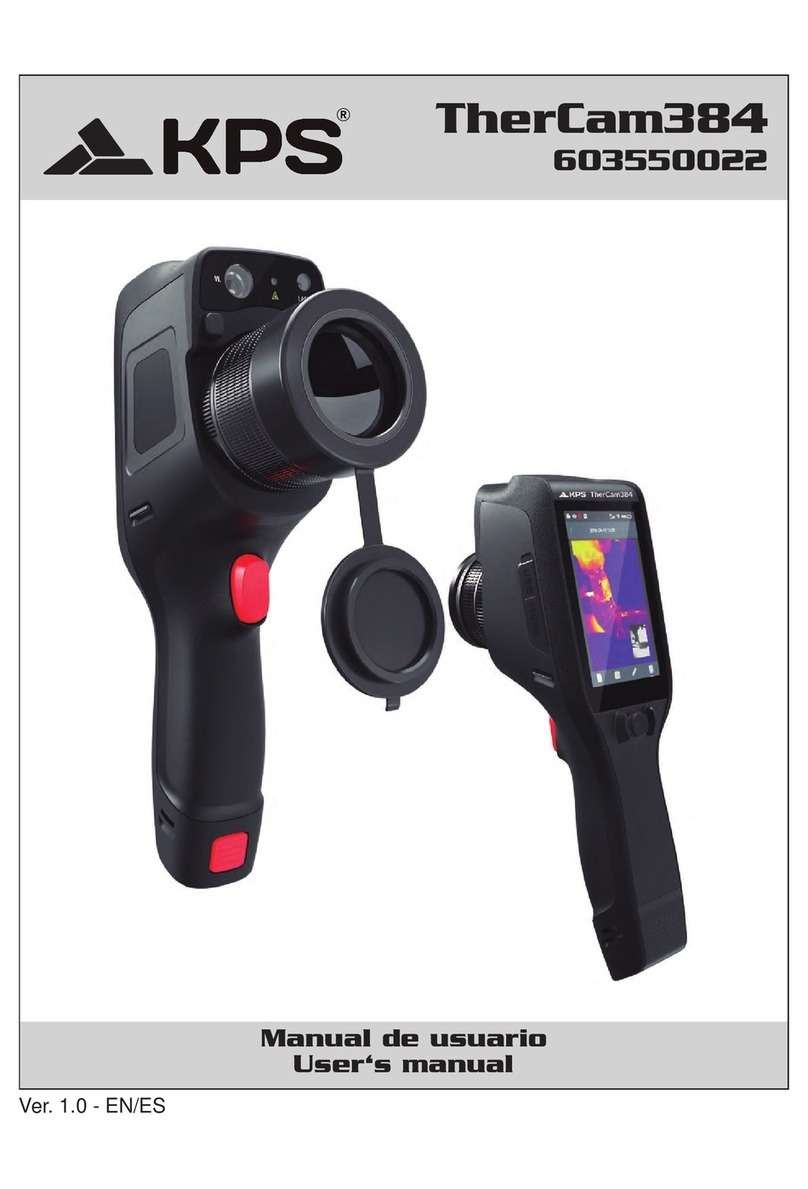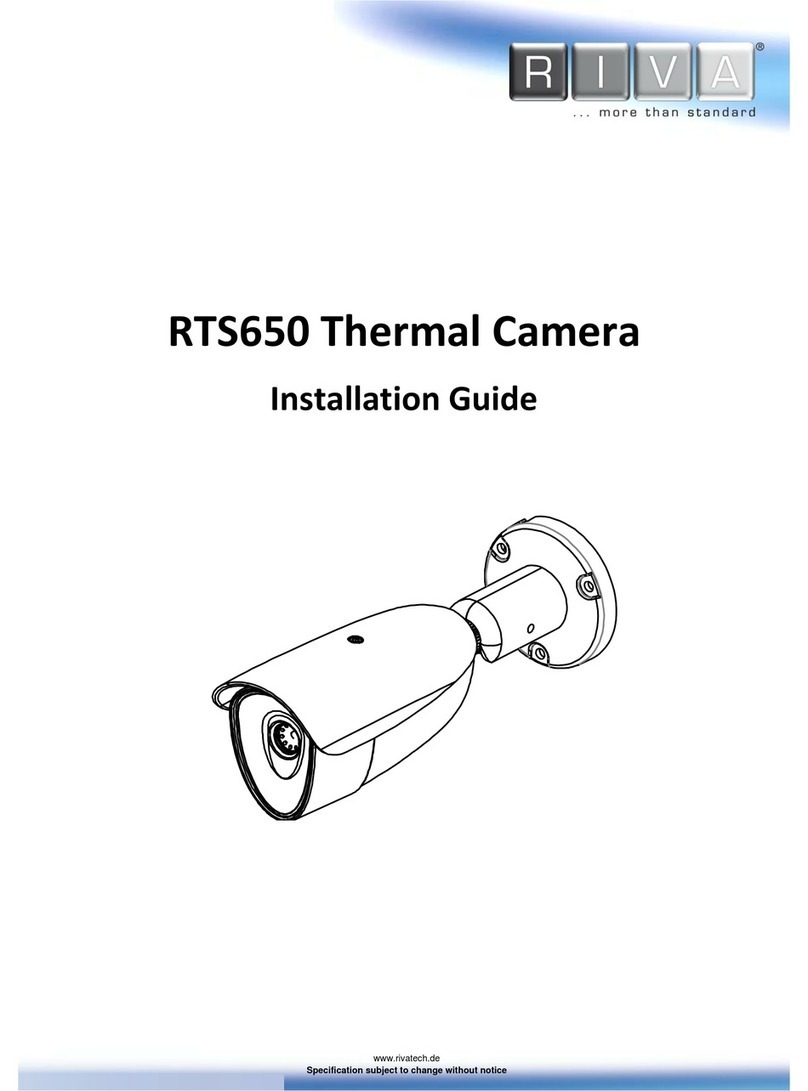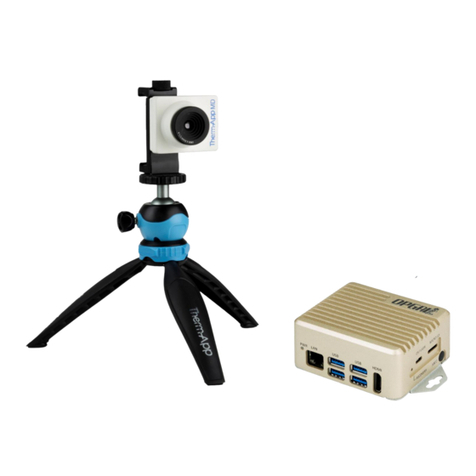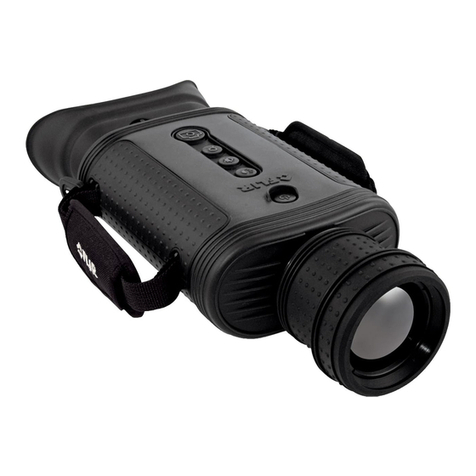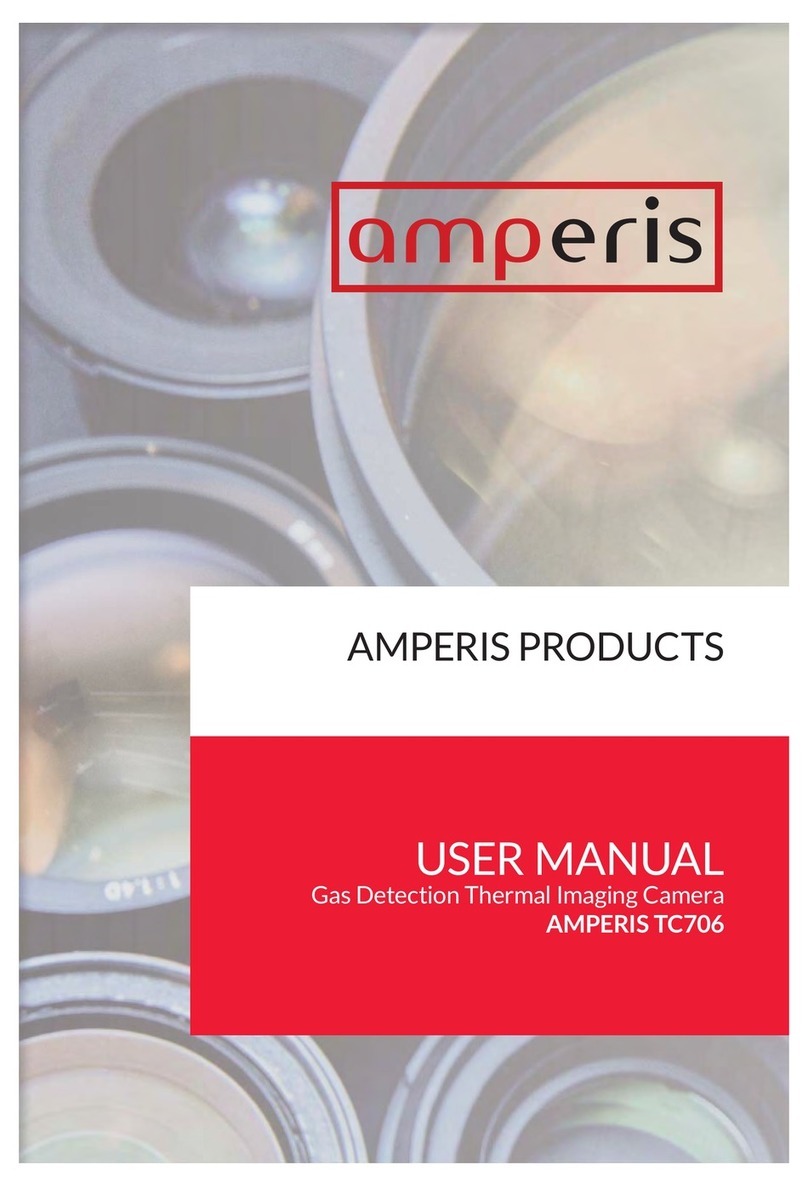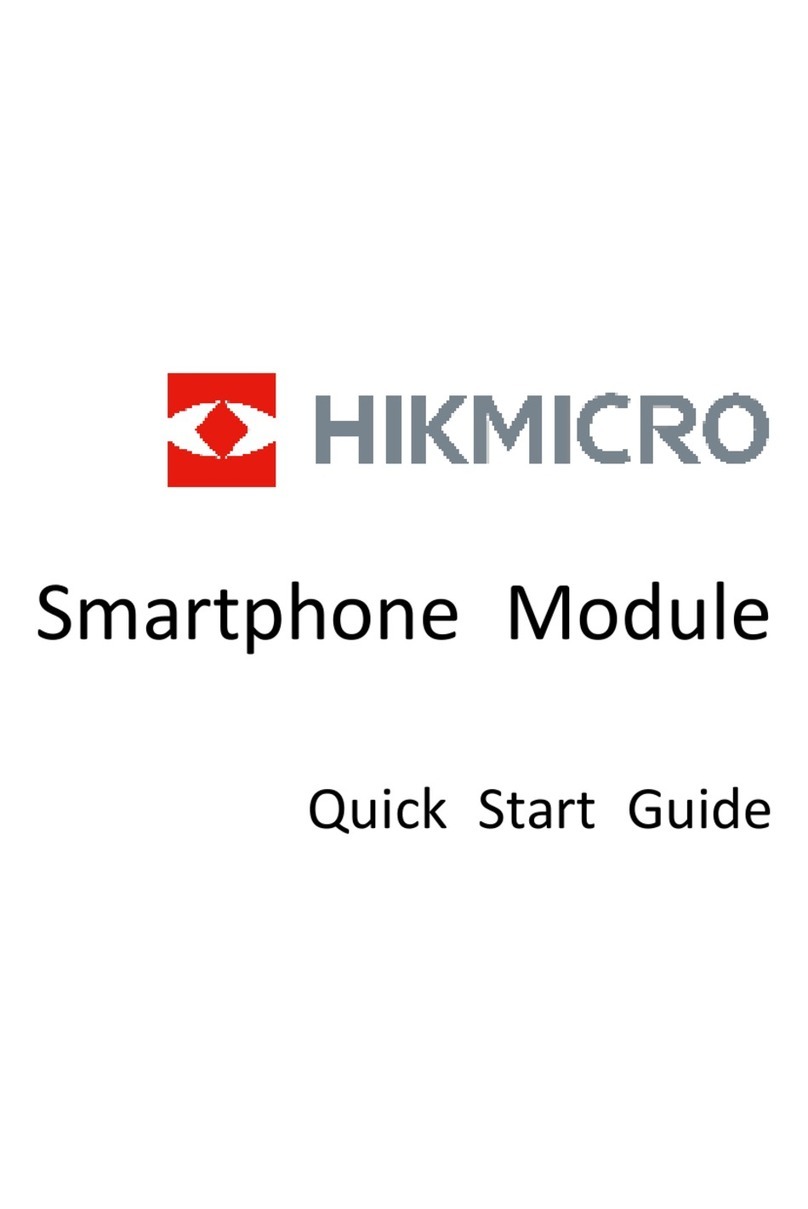Golight HELIOS User manual

37146 Old Hwy 17 | Culbertson, NE 69024
HELIOS
(Heat Enhanced Low-Light Imaging Observation System)
Instruction Manual


15
Warnings
The Helios complies with Part. 15.105 of the FCC Rules. This equipment has
been tested and found to comply with the limits for a Class B digital device.
These limits are designed to provide reasonable protection against harmful
interference in a mobile or residential installation. This equipment generates,
uses, and can radiate radio frequency energy and, if not installed and used
in accordance with the instructions, may cause harmful interference to radio
communications. However, there is no guarantee that interference will not
occur in a particular installation.
If this equipment does cause harmful interference to radio or television
reception, which can be determined by turning the equipment off and on, the
user is encouraged to try to correct the interference by one or more of the
following measures:
-Reorient or relocate the receiving antenna.
-Increase the separation between the equipment and receiver. Connect the
equipment into an outlet on a circuit different from that to which the receiver
is connected.
-Consult the dealer or an experienced technician to help.
*FCC RULE Part. 15.21 – Changes or modifications made by the user not ex-
pressly approved by Golight, Inc. for compliance could void the user’s author-
ity to operate the equipment.
Your Helios wireless remote control is a radio transmitter and receiver operat-
ing at 433MHz. Whenever the light is on, the internally mounted antenna
sends out and receives radio frequency (RF) energy.
Modern electronic equipment, i.e. personal medical devices such as pace-
makers, hearing aids, etc., are shielded from RF energy. However, RF energy
may affect some electronic equipment.
Vehicle electronic systems may be affected by RF energy. Check with your
vehicle manufacturer representative to be sure that your Helios will not affect
the electronic system of your vehicle.
Notes ______________________________________________________
_____________________________________________________________
_____________________________________________________________
Table of Contents
Introduction: Overview . . . . . . . . . . . . . . .1
Introduction: Getting Started . . . . . . . . . . . . .2
General Information . . . . . . . . . . . . . . . . .3
Warranty Information . . . . . . . . . . . . . . . .4
Maintenance . . . . . . . . . . . . . . . . . . . .4
About The Product . . . . . . . . . . . . . . . . .5
Troubleshooting . . . . . . . . . . . . . . . . . .6
Parts List. . . . . . . . . . . . . . . . . . . . . .7
Mounting & Electrical Installation for
Camera System with Wireless Remote System . . . . .8
Wireless Remote Controls: Programming . . . . . . 10
Mounting & Electrical Installation for
Cameras with Hard-Wired Remote Controls . . . . . 11
Performance Specifications . . . . . . . . . . . . 13
Warnings and Cautions . . . . . . . . . . . . . . 14
Notes . . . . . . . . . . . . . . . . . . . . . . . . . . . . 15

1
Introduction: Overview
The Helios is a state-of-the-art thermal imaging system that will provide you
with excellent night visibility and situational awareness, without any form of
natural or artificial illumination.
The Helios system is designed for simple, intuitive operation. The basic
system includes a camera assembly, wireless remote and/or a wired joystick
control panel. The system offers 370˚ horizontal rotation and a 135˚ vertical tilt
with fingertip controls. The Pan/Tilt operation has two speeds (Fast/Slow) that
are determined by pressing the speed button on the remote control.
The Helios operates using standard 12 VDC battery power and the images
from the 324 x 256 pixel detector are compatible with virtually any existing
display and recorder that accepts composite video.
The Helios is compatible with standard NTSC output, the same format used
on common television and VCR video input in the Americas and some Asian
countries. It is also available with PAL output by special order.
The Helios features a wide field-of-view and is capable of providing an image
even in absolute darkness.
Thermal Imaging Driver Vision Enhancement System
The Helios utilizes the FLIR Systems, Inc. uncooled microbolometer camera
which is a high performance, rugged, thermal imaging camera designed to
provide driver vision enhancement in adverse weather conditions and better
situational awareness than with traditional head lamps.
Different than visible light cameras, thermal imagers do not display reflected
light as seen with human eyes. Rather, thermal imaging cameras only ‘see’
temperature differences which are converted into shades of grey, from black
and white. The Helios camera displays cold objects as black and hot objects
as white.
When using a thermal imager in darkness, the image is created based on tem-
perature differences of objects in the field of view, rather than reflected light.
Furthermore, because thermal imaging cameras only ‘see’ heat sources and
not reflected light, they are ideal to assist with driver vision and situational
awareness for oncoming obstructions such as animals, people, and other
vehicles.
14
Dimensions and Weight
Dimensions (6.75” x 7.25” x 8”)
Weight: 4 Lbs.
Mounting Points: Three Screws
Warnings and Cautions
Caution! This guide uses the term Caution to indicate a potentially hazardous
situation, which, if not avoided, may result in injury, damage to the vehicle,
Helios or other property damage.
Do not operate any function that takes your attention away from safely driving
your vehicle.
Any function that requires your prolonged attention should only be performed
after coming to a complete stop. Always stop the vehicle in a safe location
before performing these functions. Failure to do so may result in an accident.
Consult your local and state driving regulations prior to installation.
In many states, using active monitors in view of the driver is prohibited.
Consult your local and state driving regulations for laws and guidelines. User
assumes all risks and indemnifies the manufacturer from any liability that may
arise from the use of this product.
Minimize display viewing while driving.
Viewing the display may distract the driver from looking ahead and may
result in an accident. The Helios thermal imaging system should not be used
as a substitution for head lamps or head lamp assisted human vision during
vehicle operation.
Use this product for 12 VDC applications only.
Use for other applications may result in excess heat, fire, equipment malfunc-
tion and may void the limited warranty.
No Export
Notice: All thermal imaging systems are subject to export control. Standard
NTSC (30Hz) and PAL (25Hz) units are subject to export restrictions and
licensing by the United States Government. Models with video frame rates at
or below 9Hz do not require licensing but do require compliance with other
export laws. Please contact Golight Inc’s export Dept. for further information.

13
Performance Specifications
Thermal Imaging Performance
Sensor Type: Uncooled microbolometer
Field Of View: 24˚ h x 18˚ v
Spectral Band: 7.5-13.5 Microns with Pixal Size of 25 Microns
Resolution: 324 x 256 pixels
Time to Image: < 2 sec.
Focal Length: 19 millimeters
Housing Enclosure
Pan/Tilt: 370˚ Rotation - 135˚ Tilt
Speed: Fast / Slow
Operation: Wired / Wireless Remote Control Options
Outputs
Video: NTSC or PAL
Connector types: Power (+/-) Video BNC/RCA
Frame Rate: 30-Hz Standard for NTSC Video, 25 Hz Optional for PAL video,
8.3 Hz Export Compliant
Note: Hz is equivalent to frames per second
Power
Power Requirements: 12 VDC nominal (range 6VDC to 16VDC)
Power Consumption: 2 Watts (nominal) 8 Watts with heater turned on
Environmental
Operating Temperature: -40˚C to +80˚C
Impact Protection: High-impact resistant window with heating element
Weather Resistance: Hermetically sealed, pressurized enclosure
2
The above images show a comparison of typical night time driving compared
to using the Helios thermal imager. The image on the left is from an ordi-
nary digital camera and shows the amount of visible light as illuminated by
oncoming headlights. The image on the right is a thermal image created by
the Helios thermal imaging camera. Note the Helios camera is sensitive to
warm objects, such as the people, and provides visibility over a much greater
distance.
Although adverse conditions such as heavy fog will affect any driver vision
enhancement system, thermal imaging cameras such as the Helios have
been shown to continue to provide useful information in conditions of re-
duced visibility, such as haze and smoke. While the Helios can assist drivers
with detection of obstructions in the vehicle’s path, thermal imagers should
not be used as the sole vision method of the driver.
The Helios is specifically designed to withstand harsh environments, with a
hermetically-sealed external housing resistant to rocks, sand, salt, and other
contaminants. Additionally, the wide operating temperature range allows the
Helios to maintain high performance in severe weather conditions.
Introduction: Getting Started
The thermal imaging camera inside the Helios is completely sealed and
extremely rugged. The camera has been qualified for operation in all types
of weather conditions over the specified operating temperature range and
includes an automatic window heater that will prevent icing under most
conditions.
Using your Helios
The Helios is easy to use, but you should take a moment to carefully read this
section so you fully understand what you are seeing on your display. While
the imagery you will see on the monitor may look like black and white day-
light video, it isn’t! A few tips on how to interpret some of the imagery will
help you to make the most of your system.

3
The camera automatically adjusts to changing scene conditions so no addi-
tional camera control is necessary. Scenes with familiar objects will be easy
to interpret with some experience. The camera automatically optimizes the
image to provide you with the best contrast in most conditions.
The thermal imager inside the camera does not sense light like conventional
cameras; it senses heat or temperature differences. As you experiment
with the system during nighttime operation, you will notice variances in the
“picture quality”; this is normal. The camera senses small “differences” in
apparent radiation from the objects in view, and displays them as either white
(or lighter shades of gray) for warmer objects, and black (or darker shades of
gray) for colder objects.
Initial System Startup
The Helios camera requires power and a connection to an external monitor to
provide imagery. Make sure to test the system prior to installation to assure
the system is functioning properly. Be sure to remove the protective window
sticker prior to test and installation.
Upon initial power up you will hear a slight clicking sound. This click is the
internal image correction. This noise is the mechanical shutter assembly
which will cause the image to momentarily “freeze.” This noise and image
freezing will occur until the unit has reached a thermally stable temperature
and periodically thereafter. See “Automatic Shutter” on page 5
General Information
On/Off function of the thermal camera is performed by depressing the On/Off
button on the Remote Control.
Note: The camera should be turned off when not in use to avoid unnecessary
power drain from the electrical system.
With the 4-way arrows on the remote control, rotate the camera to the de-
sired location. Depending upon conditions, the wireless remote may be used
up to 100 feet away from the Helios.
The speed of the camera rotation can be controlled by depressing the fast/
slow button one time and by depressing it again to restore the original speed.
12
Hard-Wired Remote Controls
The remote control has Red (+) and Black (-) power leads for the camera
system. It is recommended that these be joined using the appropriate auto-
motive or marine grade wire attachments. Each remote needs to be wired on
a single dedicated circuit and the power be fused at a minimum of 5 amps. It
is also recommended that the power wire be connected to an ignition circuit
or a separate on/off toggle between the camera and power source. Once the
power leads are attached, the 20’ wire harness needs to be attached to the
appropriate 2 and 4 pin connectors to connect with the camera.
The 25’ BNC Cable includes a BNC to RCA adapter for adaptation to a wide
variety of displays. The BNC cable needs to be attached and locked into the
camera’s BNC jack and then run to the display that is used. *Note: If a display
is included, please see the instructions for mounting and wiring the display.
Display and Camera must be wired to separate power circuits for proper
installation. See “Attaching the camera to the mounting plate” on page 8
Wired Dash Mount Toggle Without Cover
Wired Dash Mount Toggle With Cover
Fast
Pan/Tilt
Pan/Tilt
Toggle Control
Camera
On/Off
Slow
Pan/Tilt
Mounting
Holes
Mounting
Holes

11
Mounting & Electrical Installation for Cameras with
Hard-Wired Remote Controls
Determine the location for the system on your vehicle or boat. Locate the
down arrow on the base of the camera; this is to face forward and orient the
camera for full rotation. The camera will rotate 190˚ to the left and right. Cen-
ter the mounting plate with the vise screw on the mounting plate to the back.
Mark the hole locations for the three mounting screws and drill a pilot hole
for each with a 1/8 inch bit. Prior to mounting the plate, note the center of the
plate and draw a circle for the wiring hole.
Wired toggle systems will require a 3/4” hole to accommodate the power &
video wiring.
Fasten the stainless steel mounting plate with the included mounting screws;
3 ea. #10-16x3/4 type AB cross recessed pan head tapping screws. Finish the
installation with silicone sealant in each screw hole before tightening down
the mounting plate. Install the provided grommet in the ¾” hole. Bring the
power and video control cords through the grommet allowing for 1” of slack
under the light. It is suggested that the grommet hole is then sealed with a
marine grade silicone sealant to prevent leakage.
Note: Manufacturer is not liable for any leakage due to installation of the
Helios.
Install the in-dash remote control using the mounting holes in the remote
assembly. The mounting holes are exposed by removing the rubber molded
cover from the remote assembly. A 2” diameter hole needs to be drilled to
accommodate the remote control. A 3” minimum depth will be required to ac-
commodate the remote control and wiring. Place the remote in the hole and
use the four mounting holes as guides for pilot holes for the included screws.
The arrow under the rubber cover should be pointed up for proper installa-
tion. Do not screw the remote control into the dash until the electrical system
installation has been performed and tested.
4
Warranty Information
1-year Limited
Golight, Inc. warrants the Helios against any deemed defects that are due to
workmanship for parts of faulty materials, for one year from the date of the
original purchase. The warranty of the Helios does not cover damage result-
ing from unreasonable use or misuse, unreasonable maintenance or loss , or
labor costs.
Mounting the unit upside down will void the warranty.
If the Helios does fail to operate under warranted specifications, send the
camera and remote controls postage paid, plus $9.95 for shipping and han-
dling to : Golight, Inc • 37146 Old Hwy 17 • Culbertson, NE 69024. No C.O.D.’s
accepted. Only the above manufacturer is authorized to perform warranty
repair or replacement of the product.
Any consequential damages to person or property are excluded from this
warranty. Some states do not allow the exclusion and limitation of incidental
or consequential damages, therefore the above limitations or exclusions may
not apply to you. This warranty gives you specific legal rights and you may
also have other rights.
Maintenance
Product Cleaning
Caution! Do not open the camera body for any reason. Disassembly of the
camera (including removal of the cover) can cause permanent damage and
will void the warranty.
Your Helios camera generates images through an infrared transparent
window. This window is designed for harsh automotive and marine environ-
ments, but may require occasional cleaning. It is suggested that you clean
the window of the Helios when image quality degradation is noticed or exces-
sive contaminant build-up is seen on the window.
The camera housing has a durable coating and the rugged protective window
is designed to withstand normal cleaning. If the front window of the Helios
gets water spots, wipe it with a clean soft cotton cloth dampened with fresh
water. If the window requires further cleaning, use a soft moist cotton-based
cloth with isopropyl alcohol or dish soap.

5
Do not use abrasive materials, such as paper or scrub brushes as this will
possibly damage the window by scratching it. Only clean the window when
you can visually see contamination on the surface.
Temperature
The Helios camera has an operating temperature range of -40˚C to 80˚C.
Choose an installation location so that the Helios is not subject to temperature
extremes that exceed this range.
Maintenance
If you have problems, do not attempt to repair the Helios unit yourself. The
Helios camera is a water-tight, sealed unit and can not be opened or serviced
in the field. Consult your installation dealer or manufacturer.
If the camera will not produce an image, check the video connection at the
camera and at your display. If the connectors appear to be properly engaged
but the camera still does not produce an image, have an authorized service
representative make the appropriate repairs.
About The Product
Heater Element
The Helios has a built-in heating element to stabilize the window and prevent
ice build-up in cold weather conditions. The heating element is automatically
turned on when the temperature of the window falls below 4˚C and is turned
off when the temperature reaches 6˚C.
Automatic Shutter
The Helios incorporates an automatic image correction feature via the in-
ternal calibration shutter. This shutter will activate every 2 minutes or more
frequently during initial start up and large environmental temperature chang-
es. During this function, the image will be “frozen” for approximately half
a second. The frozen image will display a small white box in the left middle
portion of the image during this calibration.
In Case of Difficulty
The Helios comes with a 12 month limited warranty from the date of purchase. DO
10
Wireless Remote Controls: Programming
Wireless In-Dash & Hand-Held Remote Control Programming:
The camera is controlled with a programmable remote with different chan-
nels. This feature allows you freedom to change the channel selection, and
the receiver relearns the new selection.
Programming the transmitter
This camera has been pre-programmed at the factory, and is not necessary
to re-program the transmitter, unless you experience outside interference.
Important Note: Disconnect power by removing fuse or disconnecting vehicle
battery.
1. Remove battery cover from remote control.
2. Set the 7 dip switches to a selection of your choice. There are 3 positions
on each; positive, negative and neutral. Use a small screwdriver and se-
lect a position for each dip switch. Please note that the orientation of the
+/- switch positions may vary among different models of wireless remote
controls.
3. Make sure batteries are installed correctly and have adequate charge.
4. Replace battery cover.
5. Depress the on/off button and hold it down. Red LED will light.
6. While holding the on/off button down, reinstall the power.
7. Keep your finger on the on/off button for 5-6 seconds, and then release.
The camera should now be programmed.

9
over the front of the mounting plate. First pull the camera backwards, then
seat the back of the camera on to the mounting plate. Displace the back of
the gasket, line up the hole and install the vise screw (provided). Tighten the
vise screw using a Phillips head screwdriver. Replace the gasket to finalize
the installation.
Wireless Remote Controls:
The wireless remote control units included are one dash mount and one
hand-held. They use buttons to perform the on/off and pan/tilt functions of
the camera. All systems have a main on/off switch for the camera itself. It
is suggested that the Helios camera be turned off until it is needed; this will
save power consumption and unnecessary draw on the battery. There are
also buttons for fast/slow operation of the pan/tilt mechanism of the system.
The Turtle Button is the slow function and the Rabbit Button is the faster func-
tion for the camera. To install the dash mounted wireless remote, remove the
cover and install four screws into the mounting holes and replace cover. The
On/Off button should be at the left side of the remote.
6
NOT OPEN, MODIFY, or ALTER the Helios unit or accessories. Doing so will void any
warranty and may cause system malfunction, loss of performance, fire, or bodily harm.
The Helios is a highly sophisticated electronic imaging system. Should the
system fail for any reason, do not attempt to fix the system or wiring cables
yourself. Check wiring connections, power input, video output. If system is
not performing, please contact the manufacturer at 800-557-0098 and ask to
speak to the service department. You will need the serial number of the unit to
obtain a Return Goods Authorization.
Troubleshooting
No Video
No video image but the system is running and has power supplied to it. Place
your ear next to the camera unit. If you hear the mechanical shutter (clicking
noise) but you are not getting an image, check the video connections. The
Helios works with the most standard NTSC or PAL monitors that have 75 ohm
input.
No Video, no clicking
If video is not displayed and you do not hear a “clicking” sound from the
Helios, check the power inputs and remote control batteries if applicable.
The Helios runs on 6VDC to 16VDC power through the 25 foot power cable. If
this voltage is exceeded the unit will not function and may be damaged. The
Helios is equipped with an automatic heating element which turns on in colder
temperatures. The heater requires a few moments to stabilize the window.
Once the window is thermally stabilized the heating element will turn off auto-
matically.
The image has “lines” or screen door appearance
Check to see if the image “freezes” or if you hear a mechanical “clicking
noise” from the Helios unit. If you do not see the image freeze momentarily
(this may take a few minutes), the internal shutter may be damaged. Contact
manufacturer.
The image is shaky
Check your mounting. The Helios does not incorporate image stabilization and
must be mounted soundly and securely.
Image is dim
Check your monitor and video connections. It is recommended that you use
Wireless Dash Mount Remote
Wireless Dash Mount Remote
Pan/Tilt
Controls
Pan/Tilt
Controls
Camera
On/Off
Camera
On/Off
Slow Fast
Pan/Tilt
Slow Fast
Pan/Tilt

7
separate power supplies for the Helios and the local display to make sure you
have clean uninterrupted power.
Also, verify the Helios is connected to the 75 ohm input on the monitor. The
image may be dim if the camera is connected to an input that requires a dif-
ferent impedance.
The image is dark and no objects are seen
Recycle the power and see if you get the “Splash Screen” on the display. If
you get the Splash Screen but no image afterwards (only a black screen),
check to make sure that the window is clear of all obstructions (refer to the
maintenance section for information on window cleaning). If you do not see
the Splash Screen, check the power input and video output.
If you see the Splash Screen but no image afterwards, it is possible the me-
chanical shutter is stuck in the on position. Contact manufacturer.
Parts List
Helios w/Wireless Remote Controls:
Helios Camera
7” LCD Video Monitor w/ Mounting Hardware
25’ Video Cable w/BNC Connectors
BNC to RCA Adapter
Wireless Handheld Remote Control
Wireless In Dash Mount Remote Control
Mounting Hardware
Color: Black 3349 / White 3367
Helios w/Wired In Dash Remote Control:
Helios Camera
7” LCD Video Monitor w/ Mounting Hardware
25’ Power/Remote Control Cable
25’ Video Cable w/BNC Connection
BNC to RCA Adapter
Wired Joystick Control
Mounting Hardware
Color: Black 3321 / White 3320
8
Mounting & Electrical Installation for Camera System with
Wireless Remote System
Determine the location for the system on your vehicle or boat. Locate the
down arrow on the base of the camera; this is to face forward and orient the
camera for full rotation. The camera will rotate 190˚ to the left and right. Cen-
ter the mounting plate with the vise screw on the mounting plate to the back.
Mark the hole locations for the three mounting screws and drill a pilot hole
for each with a 1/8 inch bit. Prior to mounting the plate, note the center of the
plate and draw a circle for the wiring hole. Wireless systems will require a
¼” hole to accommodate the power & video wiring.
Fasten the stainless steel mounting plate with the included mounting screws;
3 ea. #10-16x3/4 type AB cross recessed pan head tapping screws. Finish the
installation with silicone sealant in each screw hole before tightening down
the mounting plate. Install the provided grommet in the ¼” hole. Bring the
power and video control cords through the grommet allowing for 1” of slack
under the light. It is suggested that the grommet hole is then sealed with a
marine grade silicone sealant to prevent leakage.
Note: Manufacturer is not liable for any leakage due to installation of the
Helios.
It is recommended that the 12V power wire input be joined to the leads of the
camera using the appropriate automotive or marine grade wire attachments.
Each camera needs to be wired on a single dedicated circuit and the power
be fused at a minimum of 5 amps. It is also recommended that the power wire
be connected to an ignition circuit or a separate on/off toggle between the
camera and power source.
The 25’ BNC Cable includes a BNC to RCA adapter for adaptation to a wide
variety of displays. The BNC cable needs to be attached and locked into the
camera’s BNC jack and then run to the display that is used. *Note: If a display
is included, please see the instructions for mounting and wiring the display.
Display and Camera must be wired to separate power circuits for proper
installation.
Attaching the camera to the mounting plate
To attach the camera to the mounting plate, lift up the back of the gasket
slightly to show the hole for the vise screw. Do not try to completely remove
the gasket or it may tear out of the gasket mounting points. Wet the mounting
surface with a small amount of water or lubricant for easier installation, then
place the camera over the mounting plate by sliding the front of the camera
Table of contents
